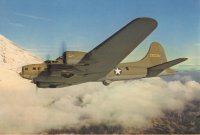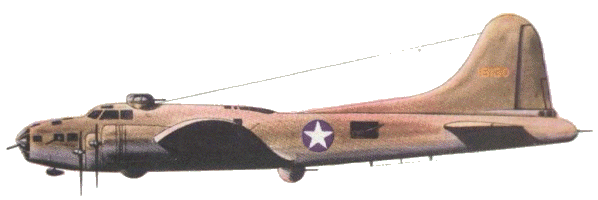 |
B-17 Flying Fortress |
Personnel
Mission Reports
 No story about the 303rd Bombardment Group (H) would be complete without
recognition and love of the airplanes in which combat crews flew. Dedicated ground
crews and maintenance personnel labored long hours to keep their assigned B-17s in the air.
Competition was keen among ground personnel in amassing the best record in safety,
flying hours and durability.
No story about the 303rd Bombardment Group (H) would be complete without
recognition and love of the airplanes in which combat crews flew. Dedicated ground
crews and maintenance personnel labored long hours to keep their assigned B-17s in the air.
Competition was keen among ground personnel in amassing the best record in safety,
flying hours and durability.
Observers of the B-17 often described it as elegant and graceful. Pilots and
crews fell in love with
her after her sturdiness, strength, reliability, forgiveness, and usefulness were exhibited. The Army Air
Corps, after original misgivings, found it an ideal aircraft to prove its strategic bombing concept of
daylight precision bombing.
The small Boeing Airplane Company of Seattle, WA, had gambled its future on its new concept
for bomber aircraft. An invitation was received from the Army on 8 August 1934 to submit a company-
owned design in a fly-off bomber design competition to be held at Wright Field in August, 1935. Boeing
concentrated its efforts on its Model 299. Army specifications demanded a multi-engine design capable
of carrying a 2000 lb. bomb load a desired distance of 2200 miles at a required top speed of 200 mph,
but a desired top speed of 250 mph. [The pilot who died in the test of Model 299 was
Ployer (Pete) Hill, for whom Hill Air Force Base is named. Hill AFB is the home of an
outstanding Aerospace Museum.]
Boeing's contest entry was rolled out of the final assembly hangar on Boeing Field, the King
County airport, on 17 July 1935. The first flight was made on 28 July. The four-engined 299 was the
sensation of the Wright Field contest, easily out-performing the twin-engine Douglas and Martin entries
in all tasks. On 30 October an Army pilot took off with the manual control lock engaged, and the plane
crashed. Since it could not complete the required tests, the 299 was disqualified; Douglas won the contest
and secured an initial order for 133 B-18's, which were essentially bomber versions of the DC-2
Transport.
The performance of the 299 had made such a great impression, however, that it received a small
"Service Test" order in spite of its crash, which was chalked up to pilot error. Thirteen military models
to be designated YB-17, plus one static test article, were ordered on 17 January 1936. The first flight of
the YIB-17, designation having been changed from YB-17, took place on 2 December 1936.
During WWII 12,731 B-17s were produced as follows:
| MODEL | FIRST FLOWN | Boeing | Douglas | Vega | TOTAL |
| 299 | 28 Jul 1935 | 1 | 0 | 0 | 1 |
| Y1B17 | 2 Dec 1936 | 13 | 0 | 0 | 13 |
| Y1B17A | 29 Apr 1938 | 1 | 0 | 0 | 1 |
| B17B | 27 Jun 1939 | 39 | 0 | 0 | 39 |
| B17C | 21 Jul 1940 | 38 | 0 | 0 | 38 |
| B17D | 3 Feb 1941 | 42 | 0 | 0 | 42 |
| B17E | 5 Sep 1941 | 512 | 0 | 0 | 512 |
| B17F | 30 May 1942 | 2,300 | 605 | 500 | 3,405 |
| B17G | 21 May 1943 | 4,035 | 2,395 | 2,250 | 8,680 |
| TOTAL | 6,981 | 3,000 | 2,750 | 12,731 | |
| 54.8% | 23.6% | 21.6% | 100% |

Original B-17 - First flown in 1935 was used up until 1939.

B-17B - Delivered well before WWII. The gun turret was removed from the nose.

B-17C and B-17D - Flush windows in place of blister turrets distinguished two models.

B-17E - Completely redesigned. Provided a tail-gun post in a longer fuselage.

B-17F - Plexiglas nose and greater bomb capacity. Available shortly after Pearl Harbor.

B-17G - Featured a chin turret, operated by remote control,
and glass-enclosed gun positions on the side of the fuselage.